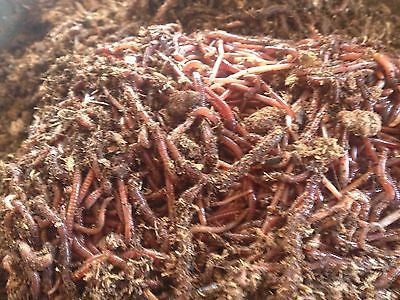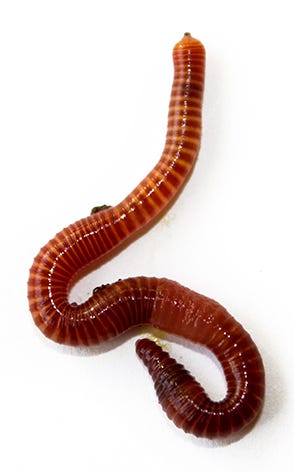Red Wiggler Worms - Perfect for Vermicomposting and Soil Enrichment
Red Wiggler Worms - Perfect for Vermicomposting and Soil Enrichment
Blog Article
Making The Most Of the Conveniences of Red Wiggler Worms: A Comprehensive Handbook for Home Gardeners and Urban Farmers
In the realm of lasting gardening techniques, red wiggler worms stand as unsung heroes, quietly changing organic waste right into nutrient-rich spreadings that can function marvels for soil health and wellness. By discovering the ins and outs of how to efficiently care for and make best use of the advantages of red wiggler worms, individuals can unlock a wealth of opportunities for boosting the sustainability and productivity of their horticulture endeavors.
Understanding Red Wiggler Worms
Red Wiggler worms, renowned for their efficient composting abilities, are a varieties of earthworms commonly made use of in vermiculture methods. These worms, medically called Eisenia fetida, thrive in rotting natural product, making them excellent candidates for composting (Red Wiggler Worms). Red Wigglers are starved eaters, efficient in eating their very own weight in natural waste daily. Their digestive procedure breaks down raw material into nutrient-rich castings, which are a beneficial resource for enhancing soil and advertising plant development.
One trick feature of Red Wiggler worms is their reproductive price. These hermaphroditic creatures possess both women and male reproductive body organs, allowing them to replicate quickly under favorable problems. A fully grown Red Wiggler can produce multiple children in a brief period, making sure a steady population within a composting system.

Establishing Up a Worm Bin
When establishing a worm bin for vermiculture objectives, proper prep work and interest to information are important for producing a helpful atmosphere for Red Wiggler worms. Begin by picking an appropriate container for your worm container. This can be a plastic or wood container with a cover to preserve dampness levels and secure the worms from light. Ensure that the bin has water drainage holes at the bottom to stop waterlogging.

Place the worm bin in a cool, dark area away from direct sunshine and extreme temperature levels. Regularly check the wetness levels, including water if the bedding really feels flaky or dry. Feed the worms a well balanced diet of fruit and veggie scraps, preventing citrus fruits, onions, and spicy foods. By complying with these steps, you can establish up a flourishing worm bin that will effectively process organic waste right into nutrient-rich vermicompost for your garden.
Feeding and Maintaining Worms
Making sure a healthy and well balanced diet is critical for the health and performance of Red Wiggler worms in a vermiculture system. It is important to avoid feeding them citrus fruits, onions, garlic, dairy items, meat, and oily foods as these can be unsafe to the worms or cause undesirable smells in the container.
Proper wetness degrees are additionally essential for the well-being of Red Wiggler worms. The bedding ought to feel like a damp sponge, offering sufficient wetness for the worms to take a breath via their skin. On a regular basis examine the moisture levels and adjust by adding water or dry bedding material as needed. Furthermore, preserving appropriate temperature conditions between 55-77 ° F(13-25 ° C )will ensure optimal worm activity and recreation. By diligently checking their diet regimen, dampness, and ecological problems, home garden enthusiasts and metropolitan farmers can sustain a efficient and healthy and balanced Red Wiggler worm populace for composting objectives.
Collecting Worm Spreadings
To efficiently remove nutrient-rich worm castings from the vermicompost, a systematic harvesting procedure is vital for making best use of the composting advantages. Red Wiggler Worms. The very first step in harvesting worm spreadings is to encourage the worms to move away of the bin. This can be attained by putting fresh food scraps on one side and leaving the various other side undisturbed for a couple of days. Once the bulk of worms have moved to the side with fresh food, the spreadings can be collected from the contrary side.
After the spreadings have been collected, it is necessary to divide any continuing to be worms from the spreadings to prevent damaging them during storage or application. One reliable method is to produce cone-shaped stacks of spreadings under brilliant light. Worms will intuitively move far from the light, enabling easy separation and elimination.
Last but not least, the harvested worm castings must be saved in an awesome, dark, and dry area to keep their quality and effectiveness as a nutrient-rich soil change. By adhering to these actions, home garden enthusiasts and city farmers can optimize the advantages of red wiggler worms in their vermicomposting systems.
Utilizing Worm Castings in Gardening
The incorporation of nutrient-rich worm castings into garden soil can substantially improve plant development and total dirt wellness. Worm spreadings, additionally called vermicast, are a natural fertilizer produced by red wiggler worms as they break down organic matter. These castings are rich in vital nutrients like nitrogen, check it out phosphorus, potassium, and valuable germs that promote plant growth and improve soil structure.
When utilizing worm spreadings in horticulture, it is vital to blend them completely right into the soil or use them as a top dressing around plants. The slow-release nature of worm spreadings makes certain a steady supply of nutrients to plants over time, decreasing the risk of nutrient leaching and promoting long-lasting dirt fertility. Furthermore, worm castings help boost dirt oygenation, water retention, and microbial task, creating a healthy atmosphere for plant origins to prosper.

Conclusion
To conclude, the utilization of red wiggler worms in home gardening and city farming can significantly benefit dirt wellness and plant growth. By comprehending just how to establish and preserve Continued a worm container, feed the worms effectively, and harvest their nutrient-rich castings, gardeners can take full advantage of the advantages of these earthworms. Incorporating worm castings right into gardening methods can improve dirt fertility and total plant productivity. Generally, red wiggler worms supply a efficient and lasting solution for improving garden and ranch returns.
In the world of sustainable gardening practices, red wiggler worms stand as unrecognized heroes, quietly Continue changing natural waste right into nutrient-rich spreadings that can function marvels for soil health.When developing a worm bin for vermiculture objectives, proper preparation and focus to detail are essential for producing a favorable atmosphere for Red Wiggler worms. The very first step in gathering worm spreadings is to urge the worms to move to one side of the container. Worm castings, likewise understood as vermicast, are an all-natural plant food generated by red wiggler worms as they damage down natural matter. By comprehending just how to set up and maintain a worm container, feed the worms appropriately, and collect their nutrient-rich spreadings, gardeners can make best use of the advantages of these earthworms.
Report this page